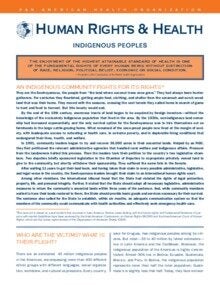AN INDIGENOUS COMMUNITY FIGHTS FOR ITS RIGHTS
They are the Sawhoyamaxa, the people from “the land where coconut trees once grew.” They had always been hunter-gatherers. For centuries they flourished, getting ample food, clothing, and shelter from the savannah and scrub woodland that was their home. They moved with the seasons, crossing the vast terrain they called home in search of game to hunt and food to harvest. But this bounty would end.
By the end of the 19th century, enormous tracts of land began to be acquired by foreign investors—without the knowledge of the exclusively indigenous population that lived in the area. By the 1930s, non-indigenous land ownership had increased exponentially, and the only survival option for the Sawhoyamaxa was to hire themselves out as farmhands in the large cattle-grazing farms. What remained of the once-proud people now lived at the margin of society, with inadequate access to schooling or health care, in extreme poverty, and in deplorable living conditions that endangered their lives, health, and welfare.
In 1991, community leaders began to try and recover 36,000 acres in their ancestral lands. Helped by an NGO, they first petitioned the relevant administrative agencies that handled rural welfare and indigenous affairs. Pressure from the landowners halted this process. Then the leaders took their petition to the country’s two legislative chambers. Two deputies briefly sponsored legislation in the Chamber of Deputies to expropriate privately owned land to give to the community, but shortly withdrew their sponsorship. They suffered the same fate in the Senate.
After waiting 11 years to get their land back, and having taken their claim to every possible administrative, legislative, and legal venue in the country, the Sawhoyamaxa leaders brought their claim to an international human rights court.
Among other violations, the international tribunal found that the State had violated the rights of legal protection, property, life, and personal integrity. Further, it stated that the State should adopt all necessary legislative, administrative measures to return the community’s ancestral lands within three years of the sentence. And, while community members waited to have their lands restored to them, the State should provide basic goods and services necessary for their survival. The sentence also called for the State to establish, within six months, an adequate communication system so that the members of the community could communicate with health authorities and effectively seek emergency health care.
|

